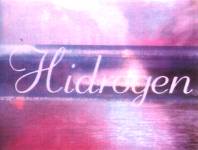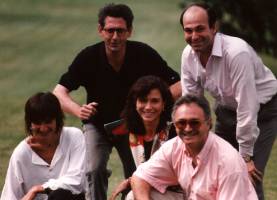hidrogen, A
PIONEERING TELEVISION PROGRAM OF ALTERNATIVE MUSICS
By: Jorge Munnshe.
Hidrogen
is a television program exclusively devoted to the Alternative
Musics. It also has been in the air for longer than
others of its kind without any interruptions. It is produced by Televisió
de Catalunya (TV3) (a television
channel having a coverage all over the region of Catalonia -Spain-
and neighbouring areas). Hidrogen began its
journey with an interview to Klaus Schulze
during his mini-tour in Spain in 1991 together with videoclips by
Enya, Paul Winter and others.
 The
program is broadcast by Canal-33, the second
channel of the local TV channel, Televisió de Catalunya.
It began as a monthly program, subject to frequent changes in its
timetable, this being a trait usually suffered by the cultural
programs on quite a number of the television channels. In spite
of this fact, it has succeeded in achieving an enthusiastic
audience, which meant it became a weekly event since May, 1993.
The
program is broadcast by Canal-33, the second
channel of the local TV channel, Televisió de Catalunya.
It began as a monthly program, subject to frequent changes in its
timetable, this being a trait usually suffered by the cultural
programs on quite a number of the television channels. In spite
of this fact, it has succeeded in achieving an enthusiastic
audience, which meant it became a weekly event since May, 1993.
The basic team is led by Albert
Reguant, an expert in Alternative Musics
coming from the recording labels sector, who is in charge of its
management and scripts.
Having a total running
time of 15 minutes each program, Hidrogen is
broadcast in stereo, and some programs are re-run during July and
August. Additionally, Canal-33 broadcasts
videoclips of Alternative Musics throughout the
week, also in stereo.
A typical program of Hidrogen
consists in 4 videoclips, an interview, the section of album
novelties divided into several headings, and an agenda
advertising the live concerts available in the area of Catalonia
and neighbouring zones, as well as the most important festivals
in Spain. From time to time, there also are special monographic
programs, such as for instance those devoted to Himekami
and Madredeus.
Some of the most
interesting interviews broadcast so far have been those referring
to: Suzanne Ciani, Michael Nyman, Nightnoise, Kitaro, Wim
Mertens, Loreena McKennit, Philip Glass and David
Bowie.
Amongst the music videos
offered, mention must be made of those starred by Kitaro,
Deuter, Michel Huygen, Philip Glass, Iury Lech, Clannad, Enya,
Serah, Paul Winter, and Eddie Jobson.
As I was getting ready to
write this article, I had the wonderful chance to be invited to
the studios at Televisió de Catalunya by the
director of the program, so that I could visit the different
technical facilities where, step by step, Hidrogen
is elaborated and share an evening with the production team. This
experience showed me that making a television program about the
new musics is far tougher than what the audience could imagine,
not merely a little more complex then a radio program. Fifteen
minutes on the air require an impressive high tech equipment and
even so they imply hours and hours of video and audio montage,
viewing, reviewing, overprinting with subtitles, elaboration of
logos and visual effects, a kind of work very akin to that done
at movie studios.
During my visit with Albert
Reguant, the one responsible for the program, I could
see him fighting the budgetary limits in his conversations with
the production manager, taking care of his script being developed
according to his indications before the difficulties pointed out
by the production team, studying the filming of concerts, all of
which adds to his permanent situation as being alone in front of
danger with respect to his job as a journalist, since almost from
the very beginning, he has been the only person to shoulder the
enormous responsibility of getting access to videos, interviews,
concerts to be filmed, novelties to be advertised, to carry out
week after week this commitment with the audience of the new
musics on television.

The elaboration of Hidrogen
begins with journalist work: being informed about album novelties
and concerts, the search for artists to be interviewed or filmed,
the access to video-clips, CDs, and other material. Films are
made at the studio or by sending a mobile team. These complete
recordings, which can last several hours, must be summarized to a
few minutes, at the same time aiming for a final result which is
coherent enough and reflects as faithfully as feasible the
essence of the unabridged version. The work to select the
segments of this summary is done by Albert Reguant
as he views in an exhaustive way the material to be processed and
then he marks the different cuts by means of the time-code (a
device that looks like a chronometer acting as a counter). The
final duration of the recording must fit exactly the one
scheduled for the program, therefore many calculations about
timing must be made besides. Once all the segments have been
selected, the visual montage is done, and it must seek the best
ways to merge the segments, using fusions, changes of plane, and
other movie-making resources. The subtitles are then added, in
such a way that they must fit the duration of the sequence and at
the same time each line requires a different duration that allows
for its being comfortably read besides fitting the total time
amount pattern. The logos and visual effects are made by means of
computers and complex systems to mix, superimpose or combine
images or their textures, which furthermore requires a well
supplied image file. This process, in Hidrogen,
requires a minimum of seven hours and two people. I was a witness
of such for the interview with Philip Glass and David
Bowie. There were some moments of nervousness and
tiredness when things didn't go the way one wanted them to go,
but these were countered by the satisfaction of the finished work
being viewed as we had a cup of coffee. Once the visual and sonic
montage are finished, Hidrogen is reviewed at an
isolated cabin, and it is then ready for broadcast: 15 minutes
that are perceived as scarce by the audience, believing that the
effort needed for them is not greater to that of any radio
program lasting much longer andd being broadcast more often.
 Previous Page (Articles/News)
Previous Page (Articles/News)
 The
program is broadcast by Canal-33, the second
channel of the local TV channel, Televisió de Catalunya.
It began as a monthly program, subject to frequent changes in its
timetable, this being a trait usually suffered by the cultural
programs on quite a number of the television channels. In spite
of this fact, it has succeeded in achieving an enthusiastic
audience, which meant it became a weekly event since May, 1993.
The
program is broadcast by Canal-33, the second
channel of the local TV channel, Televisió de Catalunya.
It began as a monthly program, subject to frequent changes in its
timetable, this being a trait usually suffered by the cultural
programs on quite a number of the television channels. In spite
of this fact, it has succeeded in achieving an enthusiastic
audience, which meant it became a weekly event since May, 1993.